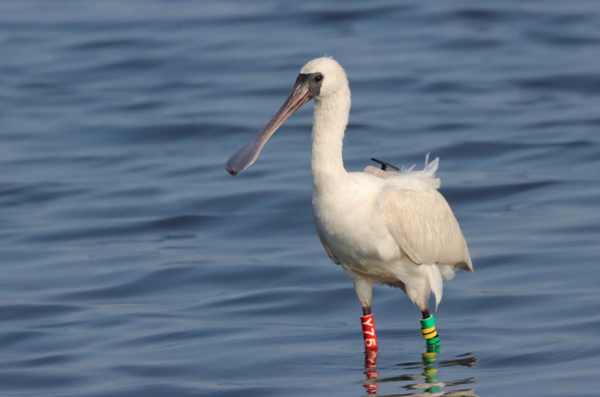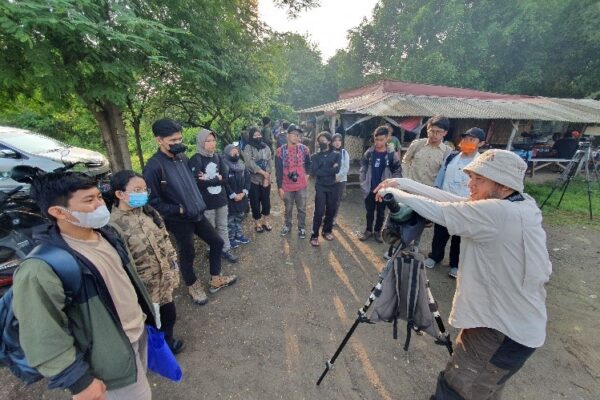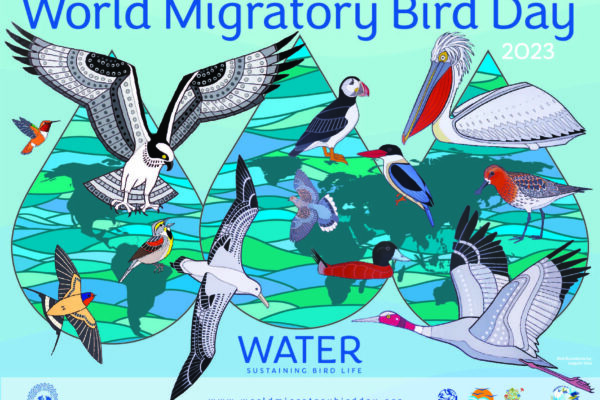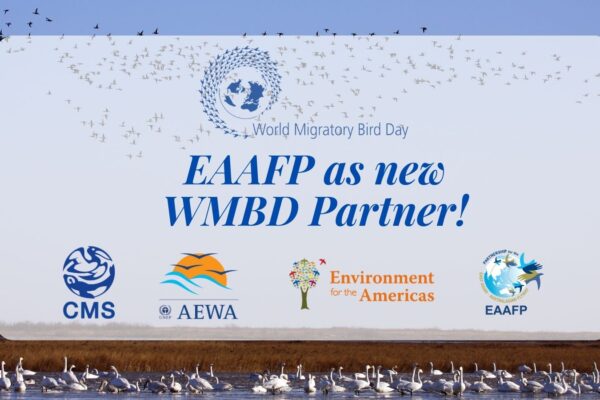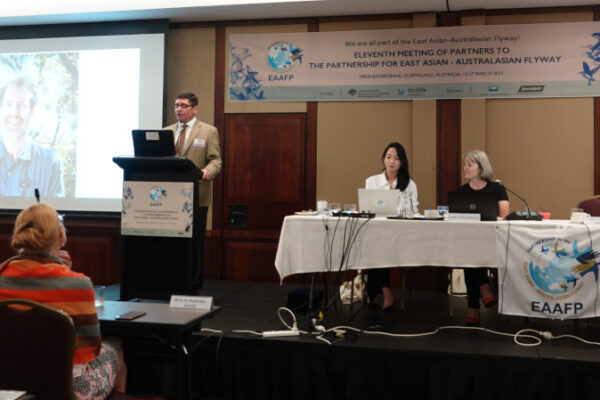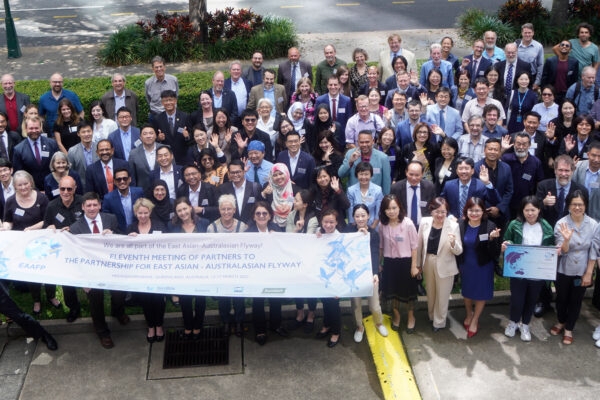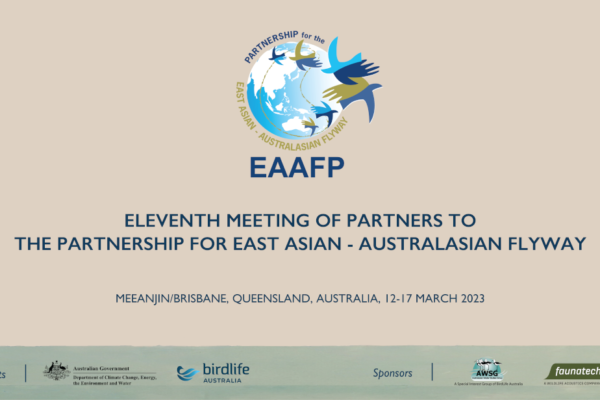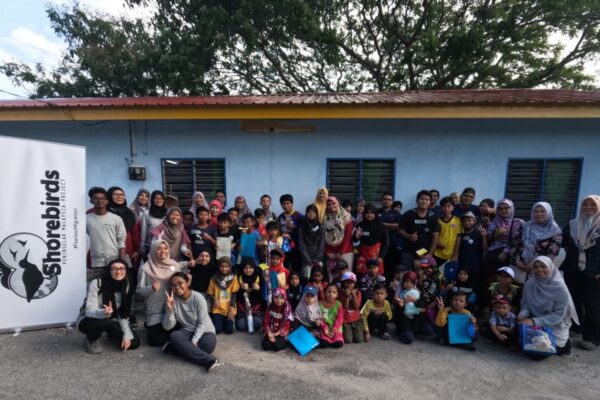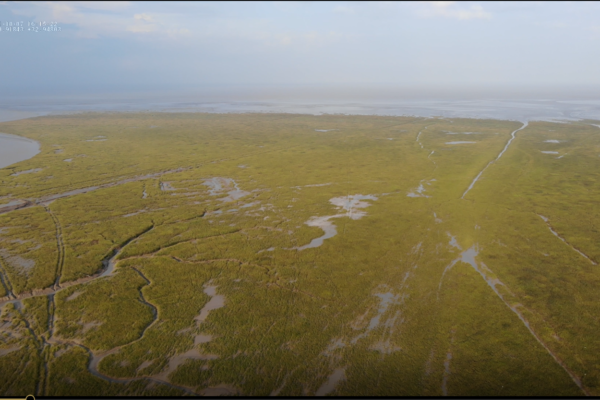-
Juvenile distribution pattern and conservation of the endangered Black-faced Spoonbill
EAAFP Small Grant Fund Project by Chi Yeung Choi, Jimmy Duke Kunshan University The individually-marked Black-faced Spoonbill ‘Y75’, was one of the twenty individuals tagged with satellite tracker. Y75 was ringed on Chilsando, Korea, 2nd July 2020, then seen on Taiwan Island 26th October 2020 ©Yi-Cheng Chen Among the threatened migratory waterbird species in the East Asian–Australasian Flyway (EAAF), the Black-faced Spoonbills (BFS) Platalea minor stands out as one of the very few species showing a recovering trend, from just a few hundred to more than 6,000 over the last 30 years partly due to the extensive conservation effort and BFSs’ ability to utilise artificial wetlands. Over the years, the foraging ecology (Yu et al. 2004a), habitat use (Yu et al. 2004b), threats (Sung et al. 2018) and migration routes (Wood et al. 2013) of BFS have been studied in various locations. Yet relatively little is known about their movement ecology, especially juveniles. In this proposed project, we aim to quantify the wintering distribution pattern of juvenile BFS in their first boreal winter using GPS-GSM transmitters. The ultimate goal is to identify the key regions where juvenile BFS winter and safeguard these areas for the continuous recovery of this endangered population. In 2020 June and July, juvenile BFS were captured near their nests from breeding islands along the west coast of South Korea. Measurements were recorded and unique colour ring combination on the tibia of BFS was used for individual marking. Solar-powered GPS/GSM satellite trackers (19g or 1.3% of juvenile BFS body weight) were deployed to the back of spoonbills using backpack method. Twenty juvenile BFS were captured and equipped with satellite trackers on their back during June and July 2020. Five individuals died without leaving Korea while one individual with tracker failure. In the remaining 14 individuals that left Korea and migrated, 10 of them (71.4%) spent their first winter in mainland China, two (14.3%) on Taiwan Island and two (14.3%) in southeast Japan. Among the 10 individuals that spent their first winter in mainland China, three individuals (30%) stayed in Jiangsu province and another three individuals (30%) in Zhejiang province, while two individuals (20%) resided in Guangdong, one individual in Hainan and one in Anhui. About half of these 14 wintering sites were protected. Among the 14 individuals that left Korea, the one that spent its first winter at the highest latitude (Jiangsu Lianyungang) and the one at the lowest latitude (Hainan) eventually died during their first winter. Our results showed the importance of the coastal wetlands in mainland China, especially those along the Jiangsu, Shanghai and Zhejiang coasts, for juvenile BFS during their southward migration and first winter. All tracked individuals that flew across the Yellow Sea from the west coast of Korea made their first landfall in coastal wetlands along the Jiangsu, Shanghai and Zhejiang coasts. The tracking results indicated the importance of coastal wetlands in Zhejiang Zhoushan, Hangzhou Bay and Wenzhou Bay to juvenile BFS. Moreover, two of the tracked birds that migrated successfully to mainland China for their first winter, eventually died at Lianyungang and Hainan. The cause of mortality was unclear but 35% of tracked BFS died within 6 months after released, showing the challenges that young BFS faced in their early years. It is important to record the potential cause of mortality and mitigate those threats to ensure the continuous population recovery of this endangered species. This project laid the important foundation for further tracking projects that will help researchers to determine the potential drivers for the observed juvenile wintering distribution pattern. This could be achieved by combining the tracking data with findings with annual synchronized censuses. Moreover, the tracking data could also be used to evaluate the extent to which protected areas along the flyway encompass the full range of habitats used by BFS during non-breeding season. The southward migration pathway and wintering distribution of satellite-tracked Black-faced Spoonbills in 2020 References: Sung Y-H, Tse IW-L, & Yu Y-T. 2018. Population trends of the Black-faced Spoonbill Platalea minor: analysis of data from international synchronised censuses. Bird Conservation International, 28(1), 157-167. Wood, C., Tomida, H., Jin-Han, K., Lee, K.S., Cho, H.J., Nishida, S., Ibrahim, J., Hur, W.H., Kim, Yu YT, & Swennen C. 2004a. Feeding of wintering Black-faced Spoonbills in Hong Kong: When and how long? Waterbirds, 27(2), 135-140. Yu YT, & Swennen C. 2004b. Habitat use of the Black-faced Spoonbill. Waterbirds, 27(2), 129-134. The project was funded through the 2020 EAAFP WG/TF Small Grant Fund. View the report, Click here.
Continue reading -
Conservation of Spoon-billed Sandpiper in the Gulf of Mottama and Tanintharyi Coastal of Myanmar
EAAFP Small Grant Fund Project by Pyae Phyo Aung, Shane Thu Lwin and Thura Soe Min Htike Nature Conservation Society – Myanmar (NCS) LCG members are looking the spotting the scope and binocular during the bird watching training © Nature Conservation Society – Myanmar Participation of local communities in conservation is crucial for long-term conservation management. Two local Conservation Groups(LCGs) newly established in The Tanintharyi region are improved their conservation skills through five consecutive bird-watching training sessions. Two LCGs from the area of the Gulf of Mottama are also trained to elaborate their bird-watching, patrolling and conservation skills. Vinyl billboards were installed in the public areas of Myeik and Boke Pyin to raise the awareness of the conservation of migratory shorebirds during their wintering season. This year, 2021-2022 a total of nine national surveyors conducted an annual wintering census survey of Spoon-billed Sandpiper and migratory shorebirds at the Gulf of Mottama and Tanintharyi coastal accompanied by the LCGs members. For the Gulf of Mottama Ramsar site, the survey team covered upper Gulf located in east coastal where recorded 17 and estimated 80 critically endangered Spoon-billed Sandpiper (SBS), based on the SBS proportion in 173 flock counts of over 34,914 birds extrapolated to an estimated 160,000 birds of small waders in the area. These birds were encountered by the team at low tide feeding and widespread across the vast mudflat habitats. Former hunters of the Local Conservation Groups (LCGs) joined the survey and guided the survey team onto the small wader flocks. They were trained and informed about the survey techniques, biology and significance of the species in a regional, national and global context. Providing binoculars to LCG team © Nature Conservation Society – Myanmar Survey team members with LCG at the Gulf of Mottama © Nature Conservation Society – Myanmar Three sites located at the North of Myeik mudflat, recorded ten globally threatened species such as Nordmann’s Green Shank, Great Knot, Chinese Egret, Black-headed Ibis, Bar-tailed Godwit, Black-tailed Godwit, Eurasian Curlew, Curlew Sandpiper, Red-necked/Little Stint and Red-breasted Parakeet. Three sites located at the Bokepyin mudflat, recorded twelve globally threatened species such as single Spoon-billed Sandpiper, Black-tailed Godwit, Bar-tailed Godwit, Eurasian Curlew, Nordmann’s Greenshank. During the project implementation period, NCS keep communicating with the existing LCG members in the Gulf of Mottama for the conservation actions and formation the new LCG team at Tanintharyi coastal region. Tanintharyi costal region is also important for migratory water birds and needs to be conserved as a legal flyway network site or Ramsar Site. Moreover, the NCS team is coordinating with Tanintharyi region Forest Department for the Spoon-billed Sandpiper conservation activities and introducing Tanintharyi coastal as a new flyway network site. Discussion between NCS and Officers from Forest Department for shorebird conservation, Tanintharyi Region via Zoom on 30 November 2021© Nature Conservation Society – Myanmar The project was funded through the 2021 EAAFP WG/TF Small Grant Fund. View the report, Click here.
Continue reading -
Skilled Stakeholder Meets Technology: The Next Step of Migratory Waterbirds Conservation in Indonesia
EAAFP Small Grant Fund Project by Ragil Rihadini Yayasan Ekologi Satwa Alam Liar Indonesia (EKSAI Foundation) Indonesia, is one of the important wintering habitats for migratory waterbirds. With a total of 19.181 km shoreline (KKP, 2019), the information about migratory waterbirds in Indonesia is still little. Most records and information cantered in Java and Sumatra Island, this caused threats on the unknown potential sites (fig.01). Fig.01. Shorebirds Data (in red) from 2016-2022; source: burungnesia app. Many migratory waterbirds' important sites in Indonesia are not protected yet, some other are predicted as important sites but it needs more data and information to confirm that. Unfortunately, some of those areas do not have any birdwatchers who skilled in shorebirds identification. Meanwhile, threats such as hunting, habitat change, and other human disturbance frequently recorded in Indonesia; as the local people rarely understand the importance of conserving the waterbirds. As from our survey before proposing this project to the EAAFP, more than 60% of local birdwatchers are not familiar with waterbirds, and more than 70% are not familiar with migration and shorebirds. This makes us hard to access information about migratory shorebirds in Indonesia, and several times during our survey on new sites, we will find people hunting for waterbirds, simply because they did not know what is that, and how important it is to conserve the birds. The need for skilled birdwatchers as conservation agents: citizen scientists, bird researchers, college students, and government agencies to do regular and systematic surveys on the nearest potential habitat of migratory waterbirds. Fig.02. Field Training of Local Stakeholders in Indonesia Need of coordinated monitoring; cantered data (waterbirds database) that will help the scientists and management coordinator to determine the suitable action for shorebird conservation base on that data and information. With no coordinated monitoring and hunting assessment for migratory waterbird conservation, it will be hard to control threats and protect the birds (Eduardo et al, 2020). Fig.03 (a) the illustration of burungnesia.app (b) the data of Nordmann Greenshank in Indonesia from burungnesia app With support from the East Asia Australasia Flyway Partnership (EAAFP), we were able to combine conservation action and technology through a conservation training activity in Indonesia last November – December, 2022. The small grant from the EAAFP makes us able to reach and develop the shorebirds conservation skills and knowledge of at least 30 of local stakeholders from all around Indonesia (from Papua to Sumatra); covers the government agencies, national parks’ agents, college students, birdwatchers, and local NGOs representative. They got several materials about migratory waterbird conservation during the training: creating a community and research-based conservation program; shorebirds habitat management; shorebirds identification, etc. They also got access to discussing their on-field problems with experts during and after the training. In the process to creating a coordinated monitoring and shorebirds database in Indonesia, we collaborate with our partners in Burungnesia.app; an android application for submitting birds checklists. All the trained participants are mandatory to install and register in Burungnesia.app; they also train on how to submit and using this app. By combining the skilled stakeholders and this technology we hope the data, information, and study about migratory shorebirds in Indonesia will increase, also the conservation action and protection of shorebirds in Indonesia will become a serious attention. The project was funded through the 2022 EAAFP WG/TF Small Grant Fund. View the report, Click here.
Continue reading -
World Migratory Bird Day 2023 Global Campaign Poster Unveiled
We are pleased to present the 2023 World Migratory Bird Day global campaign poster. Featuring the work of Nicaraguan artist Augusto Silva, the poster shows twelve species that help tell the story of the importance of water to migratory birds. The selected bird species remind us that birds and many other species need wetlands for migration, wintering, and breeding. Some birds require specific types of water habitats, such as the tidal flats that Spoon-billed Sandpipers use during migration and winter, the mangrove forests and other coastal areas favored by Black-capped Kingfisher, open water for Dalmatian Pelican and Maccoa Duck to breed and the seasonally flooded fields in which the Sarus Crane uses. Water is essential for the survival of insects pursued by the Barn Swallow, the growth of nectar-producing plants frequented by the Rufous Hummingbird, and the health of grasslands inhabited by the Dickcissel and riverine forests used by the European Turtle Dove. The Atlantic Puffin and Wandering Albatross represent the oceans that make up 97% of all water on earth and are becoming increasingly polluted with chemicals and plastic waste. And finally, the Osprey serves as a conservation success story, reminding us that bird population declines can be reversed when we work together to conserve and protect our planet. The poster supports the theme of this year’s World Migratory Bird Day, which is “Water: Sustaining Bird Life,” a call of attention to the importance of water and its associated habitats to migratory birds. Unfortunately, increasing human demand for water, as well as human-driven pollution and climate change, threaten many of the water areas on which migratory birds depend. World Migratory Bird Day raises awareness of these issues and serves as a call to action for the protection of birds and their habitats. The two peak days of World Migratory Bird Day 2023 will be 13 May and 14 October, reflecting the cyclical nature of seasonal bird migrations. Events will take place all over the world in parks, nature centers, museums, libraries, schools, and other locations on those two peak days as well as throughout the year. To find an event near you, to register your own event, or to download this year’s campaign poster in multiple languages, go to worldmigratorybirdday.org. The EAAFP Secretariat is calling for support to translate the global poster to your own language, and to share the planned World Migratory Bird Day activities with us. If you require the design file of the poster, or are interested in supporting or involving in World Migratory Bird Day, please contact wmbd@eaaflyway.net.
Continue reading -
New Partnership Strengthens Global Campaign for Migratory Birds
East Asian-Australasian Flyway Partnership (EAAFP) Becomes Official Partner of World Migratory Bird Day Today, the East Asian-Australasian Flyway Partnership (EAAFP) was announced as an official Partner of the World Migratory Bird Day campaign during the 11th Meeting of Partners (MOP11) of the EAAFP which was held in Brisbane, Australia. The new Partnership unites efforts to raise awareness to conserve migratory birds globally. World Migratory Bird Day is an annual global awareness-raising campaign to celebrate the amazing journeys of migratory birds, and to inspire worldwide conservation of migratory birds and their habitats. Traditionally observed on the second Saturday of May and October, the two days of World Migratory Bird Day are a way to reflect the cyclical nature of bird migration as well as the fact that there are varying peak migration periods in the northern and southern hemispheres. The campaign is a joint effort of the Convention on the Conservation of Migratory Species of Wild Animals (CMS), the African-Eurasian Migratory Waterbird Agreement (AEWA), Environment for the Americas and the EAAFP. The addition of the EAAFP to this Partnership will strengthen engagement and awareness for migratory birds in the East Asian-Australasian Flyway. Ms. Amy Fraenkel, Executive Secretary of the Convention on the Conservation of Migratory Species of Wild Animals said “I am confident that the new partnership with EAAFP will open new horizons for global migratory bird conservation and strengthen our common effort to raise awareness of migratory birds and the importance of international cooperation to conserve them.” Dr. Jacques Trouvilliez, AEWA's Executive Secretary said “It is my sincere hope that the signing of this partnership agreement and the good inter-flyway cooperation we have built in the context of World Migratory Bird Day will continue to grow. It is the spirit of flyway conservation and the recognition that international cooperation is essential to conserve migratory birds that unite us and helps carry our message across the world.” Dr. Susan Bonfield, Executive Director of Environment for the Americas highlighted “Birds do not recognize the presence of political borders. With this partnership agreement, we express our unwavering dedication to safeguarding migratory birds throughout their flyways and promoting the connections between people and birds on the occasion of World Migratory Bird Day. Together, our organizations pledge to collaborate towards the global conservation of migratory birds.” Mr. Robb Kaler, Chair of the East Asian-Australasian Flyway Partnership said “We are thrilled to join as a new Partner to World Migratory Bird Day and to collaborate with CMS, AEWA and EFTA! The new partnership will allow stronger collaboration, inspire more great ideas and make a wider impact on the conservation of migratory birds on a global level. The EAAFP is committed to voice out the message to conserve migratory birds together.” Speech by Mr. Robb Kaler, Chair of EAAFP to announce the WMBD Partnership during EAAFP MOP11. ©EAAFP Secretariat The theme of World Migratory Bird Day in 2023 is “Water: Sustaining Bird Life” and will be used to highlight the importance of water for migratory birds. Inland and coastal wetlands, rivers, lakes, streams, marshes, and ponds are all vital for feeding, drinking, or nesting, and also as places to rest and refuel during their long journeys. Unfortunately, many of these water bodies and aquatic ecosystems are becoming increasingly threatened around the world and so are the migratory birds that depend on them. The two peak days of World Migratory Bird Day 2023 will be 13 May and 14 October, reflecting the cyclical nature of bird migration with varying migration periods in the northern and southern hemispheres. Learn more about World Migratory Bird Day www.migratorybirdday.org Other Press releases: CMS: https://www.cms.int/en/news/new-partnership-strengthens-global-campaign-migratory-birds-0 Environews Nigeria: https://www.environewsnigeria.com/new-partnership-strengthens-global-campaign-for-migratory-birds/
Continue reading -
MOP11 concluded with stronger commitment in collaboration for conserving migratory waterbirds in East Asian-Australasian Flyway
The EAAFP 11th Meeting of Partners (MOP11) held in Brisbane, Australia, on 17 March, 2023 ended with the adoption of 11 Decisions, the election and appointment of new Management Committee, and the announcement of EAAFP as official partner to World Migratory Bird Day. After 4 days of intensive discussion, the closing day of EAAFP concluded with the adoption of 11 Decisions. These include the (highlighted DD to be named: new CEPA Action Plan 2023 – 2028, new Guidelines for National, Site and Sister Site Partnerships, Maintaining up-to-date Population Estimates and Trends of Migratory Waterbird Populations for the EAAFP, Youth mainstreaming, and more, which will guide Partners, Site managers, collaborators and other stakeholders to take concrete actions for the conservation of migratory waterbirds and wetlands in East Asian-Australasian Flyway (EAAF). During the plenary, a special presentation was given by Her Excellency, Clare Fearnley, former New Zealand Ambassador to China in a recorded message. She shared the launch of ‘Friends of the Flyway’ which she initiated, to celebrate the migratory birds of the EAAF, bringing together ambassadors and senior diplomats. Mr. Suh Sheung-Oh, Director of the Ramsar Regional Centre – East Asia, shared the recently combined Wetland Link International – Asia-Oceania, which is a network of wetland education centres and site managers. H.E. Clare Fearnley, former New Zealand Ambassador to China delivered recorded message ©EAAFP Secretariat Mr. Suh Sheung-Oh, Director of RRC-EA, shared Wetland Link International – Asia-Oceania ©EAAFP Secretariat Youth representative, Hou Shuyu, winner of the Youth Think Tank Competition from China and Lena Van Swinderen from Australia presented a vision from the youth perspective for how they could be engaged in EAAFP, as well we the youth Declaration of 2020 Flyway Youth Forum was presented at the plenary. It is followed by presentations by Sponsors to the MOP11 – Ms. Alison Russell-French and Birgita Hansen on behalf of the Australasian Wader Study Group and Ms. May-Le Ng for Faunatech. After that, the plenary session continued with discussion on the election and appointment of the Management Committee, Technical SubCommittee and Finance Subcommittee. Australia became the Chair and Cambodia as the Vice Chair of the Management Committee. The highlight towards the end of the MOP11 was an announcement of EAAFP as the Official Partner of World Migratory Bird Day, an annual global campaign to raise awareness of migratory birds. Recorded video messages from Amy Fraenkel, Executive Secretary of the Convention on the Conservation of Migratory Species, Dr. Jacques Trouvilliez, AEWA's Executive Secretary and Dr. Susan Bonfield, Executive Director of Environment for the Americas were delivered to convey the celebratory messages to welcome EAAFP as the new Partner to the World Migratory Bird Day, followed by a speech from Mr. Robb Kaler, Chair of EAAFP to announce the official Partnership (link). Closing remarks by Dr. Ilse Kiessling, Assistant Secretary, Protected Species and Communities Branch, Biodiversity Conservation Division, DCCEEW ©EAAFP Secretariat Closing remarks by Mr. Robb Kaler, Chair of EAAFP©EAAFP Secretariat Closing remarks by Mr. Doug Watkins, Chief Executive of EAAFP Secretariat ©EAAFP Secretariat At the closing ceremony, Mr. Robb Kaler, Chair of EAAFP commented“As you all know, the Partners adopted a 10-year Strategic Plan at MOP10 to guide our Partners. A plan is just a document if there is no implementation, but today we are fortunate to see many Partners and stakeholders are all paying efforts towards the same goal: To conserve migratory waterbirds, their habitats, and the livelihoods of people who depend on them.” Mr. Doug Watkins, Chief Executive of EAAFP said “It has been fantastic to meet with the Partners again. I hope the meeting has reinvigorated us to work smarter for the conservation of internationally important wetlands and the migratory waterbirds they support.” Learn more about MOP11 and updates: https://www.eaaflyway.net/11th-meeting-of-partners-mop-11/ News release of MOP11 by Partners: Hanns Seidel Foundation Korea: https://korea.hss.de/en/news/detail/weltzugvogeltag-2023-news9958/ Mygoyang News (Korean): https://www.mygoyang.com/news/articleView.html?idxno=7223 ABC News: https://www.abc.net.au/news/2023-04-25/proposed-development-on-protected-wetlands-at/102265270
Continue reading -
The East Asian – Australasian Flyway Partnership (EAAFP) kicked off the 11th Meeting of Partners in Brisbane, Queensland, Australia to jointly conserve migratory waterbirds from the most threatened flyway in the world
Group photo of EAAFP © EAAFP Secretariat On 13th March, the 11th Meeting of Partners (MOP11) of the East - Australasian Asian Flyway Partnership (EAAFP) officially kicked off in Brisbane, Queensland, Australia, under the theme “We are all part of the East Asian-Australasian Flyway!”. Co-hosted by the Department of Climate Change, Energy, the Environment and Water, Australian Government and BirdLife Australia, and sponsored by Australasian Wader Study Group and Faunatech, the meeting brought together over 150 participants from 18 national governments, inter-government organizations, international NGOs, site managers, experts and corporates. The delegates will lead the discussion on the eleventh key Draft Decisions to find a solution and better direction to conserve migratory waterbirds, their habitats and livelihoods in the Flyway. The meeting was opened with a traditional aboriginal Welcome to Country performance delivered by Tribal Experiences. The MOP11 was officially opened through welcome remarks by the co-hosts, Dr Ilse Kiessling, Assistant Secretary, Protected Species and Communities Branch, Biodiversity Conservation Division, Department of Climate Change, Energy, the Environment and Water, and Prof. Martine Maron, President of BirdLife Australia. Dr Ilse Kiessling, Assistant Secretary, Protected Species and Communities Branch, Biodiversity Conservation Division, DCCEEW © EAAFP Secretariat Prof. Martine Maron, President of BirdLife Australia © EAAFP Secretariat "We are thrilled to bring together our partners from across the Flyway to share knowledge, learn from one another, and plan for the future of migratory waterbird conservation," said Martine Maron, President of BirdLife Australia, co-host of MOP11. "This meeting is a critical opportunity to engage with a diverse group of stakeholders and strengthen our collective efforts to protect the flyway." Dr. Musonda Mumba, Secretary General of the Ramsar Convention also delivered a recorded congratulatory message to EAAFP MOP11. After, Mr. Robb Kaler, Chair of EAAFP gave opening remarks, followed by a memorial ceremony dedicated to Dr. Lew Young, former Chief Executive of the EAAFP Secretariat, and Dr Evgeny Syroechkovskiy, former EAAFP Spoon-billed Sandpiper Task Force Chair and Focal Point of Russia. In his opening remarks, Mr. Robb Kaler, Chair of EAAFP said “No single country can conserve all the migratory waterbirds, only if we collaborate and amplify our effort can the waterbirds be conserved and wetlands be sustainably managers, “highlighted Mr. Robb Kaler, Chair of EAAFP. “I hope that this MOP proves to bolster the effort of the Partnership to continue their tireless work of preservation of migratory birds and their habitats within our precious Flyway.” Dr. Musonda Mumba, Secretary General of the Ramsar Convention © EAAFP Secretariat Mr. Robb Kaler, Chair of EAAFP © EAAFP Secretariat During the opening ceremony, the Partnership welcomed the two new Partners, Hong Kong Bird Watching Society and Mangrove Foundation, and 11 new Flyway Network Sites from Australia, Cambodia, China, Japan, Myanmar and the Republic of Korea since the 10th Meeting of Partners (MOP10). Two Sister Sites agreements were celebrated between Incheon, Republic of Korea and Hong Kong S.A.R., China, as well as Saga City, Japan and Alaska, U.S.A. Mr. Yat-tung Yu, Director of new Partner, Hong Kong Bird Watching Society (HKBWS), said, “Hong Kong lies in the middle of the East Asian-Australasian Flyway. Thousands of waterbirds including globally threatened Black-faced Spoonbill, Spoon-billed Sandpiper and Saunders’s Gull utilise Mai Po Inner Deep Bay Flyway Site for wintering and passage. The HKBWS is privileged to join the EAAFP and eager to work with other partners for more collaborative and impactful conservation activities to protect waterbirds and their habitats with local, regional and global perspectives." Dr. Baohua Yan, Secretary-general of new Partner, Mangrove Foundation (MCF), expressed “MCF is a leading wetland and biodiversity conservation charity in China, with the mission of living wetlands and sustainable future. It employs a social participation model for nature conservation through adaptive management of protected areas, CEPA (wetland education and public engagement), network building, grantmaking and international collaboration. It does this through strategic projects, such as Saving the Spoon-billed Sandpipers, Mangrove Conservation and Restoration, Active Wetland Management in Shenzhen Bay, and China Wetland Center Network.” Mr Yat Tung Yu, Director of Hong Kong Bird Watching Society, New Partner to EAAFP © EAAFP Secretariat Ms. Sun Lili, Founder, and Board Member, Mangrove Foundation, New Partner to EAAFP © EAAFP Secretariat Following the Ceremonies, Prof. Richard Fuller from the University of Queensland gave a keynote presentation, illustrating the critical situation that some shorebirds are declining, and how we can save the migratory waterbirds. After the opening ceremony, two side events to introduce and discuss the revised CEPA Action Plan and the new Guidelines of National, Site and Sister Site Partnerships, as well as "Green Energy and Conservation of Migratory Birds" respectively. In the afternoon plenary session, the Partners adopted the Rules of Procedure and elected Australia as Chair and U.S.A. as Vice Chair to the MOP11. At the end of the first day, BirdLife Australia organized the opening performance, music played by Bowerbird Collective, with a song “Life on Land's Edge “, and the participants to MOP11 were treated to the opening reception hosted by the Australian Government and BirdLife Australia. In the upcoming meeting, Partners and collaborators will contribute to discussing Document papers and 11 Decision papers, which will enhance efficiency in Partnership operation, including CEPA Action Plan, and establishing the new guidelines of national, site and Sister Site Partnerships, Population Estimates and Trends of Migratory Waterbird Populations. In the following days until 17th March, there will also be 11 side events organized to foster collaboration, knowledge-sharing, and strengthening the Partnership in the future, and working towards synergizing the work of EAAFP with Multilateral Environment Agreements (MEAs) and different regional conservation initiatives and mechanisms. Opening performance "Life on Land's Edge “ music played by Bowerbird Collective © EAAFP Secretariat Learn more about MOP11 and updates: https://www.eaaflyway.net/11th-meeting-of-partners-mop-11/ Photo album on 13th March: https://www.flickr.com/photos/eaafp/sets/72177720307070189/
Continue reading -
Over 150 delegates meet in Brisbane, Australia to discuss the conservation of migratory waterbirds
The East-Australasian Asian Flyway Partnership (EAAFP), a partnership of governments, NGOs, and experts working to conserve migratory waterbirds and their habitats, is pleased to announce the upcoming 11th Meeting of Partners (MOP11) in Brisbane, Australia, from 12th to 17th March, 2023. The global migratory waterbird population is experiencing declines of up to 80% over the last 30 years, with the East Asian-Australasian Flyway (EAAF), which stretches from the Russia Far East and Alaska to Australia and New Zealand in the south, having the highest proportion of globally threatened species among all flyways. The destruction and degradation of wetlands along the Flyway impact the waterbirds’ survival. The MOP11 is co-hosted by the Department of Climate Change, Energy, the Environment and Water of the Australian Government and BirdLife Australia, and sponsored by the Australasian Wader Study Group and Faunatech. The theme of the MOP is “We are all part of the East-Asian Australasian Flyway!” and brings together over 150 partners and collaborators from across the 18 range countries and beyond to discuss the latest developments in migratory waterbird conservation. Established in 2006, the EAAFP aims to conserve migratory waterbirds, their habitats and the livelihood of local people depending on them along the East Asian-Australasian Flyway (EAAF). The Partnership includes government bodies, inter-governmental organizations, INGOs, international organizations, corporations, scientific experts, site managers, and local communities. The importance of protecting migratory waterbirds and wetlands The East Asian-Australasian Flyway is home to over 50 million migratory waterbirds of more than 210 species, using various types of wetland habitats to breed, rest and forage. Many of them, such as Bar-tailed Godwit, and Far Eastern Curlew, fly over thousands of kilometres for migration twice every year. Globally, wetlands are being cleared and damaged, and their water is diverted and drained for agriculture or aquaculture, and to make way for development. They are also threatened by the growing impact of climate change, like increasing droughts and fires, as well as growing pressures from overgrazing and invasive species, and more recently diseases like Avian Influenza. 11th Meeting of Partners encourages synergies to take conservation actions This upcoming meeting is the first since the establishment of the EAAFP Strategic Plan 2019 – 2028. It will be an opportunity to understand how the Partners are aligning our actions to the strategic plan, and allow participants to share knowledge and experiences, discuss new and ongoing initiatives, and plan for future conservation efforts. The week-long meeting will feature discussions of key issues raised by Partners, and interactive side events covering regional collaboration, allowing partners to exchange ideas and build strong networks to support the partnership's work. In addition, MOP11 will include a field trip to the Moreton Bay wetland, a Flyway Network Site of the EAAFP, and critical for migratory birds like the endangered Far Eastern Curlew. About MOP11, click here. Far Eastern Curlew © Maria Coleman
Continue reading -
Asian Waterbird Conservation Fund (AWCF) 2023 : More partnerships are coming!
On today’s World Wildlife Day, WWF-Hong Kong is pleased to announce the successful application result for the Asian Waterbird Conservation Fund (AWCF)! This year, the AWCF will support Pusat Riset Konservasi Gajah dan Biodiversitas Hutan (PKGB) and University of Syiah Kuala Banda Aceh to continue the project “Mapping migratory waterbirds poaching on the East Coast of Aceh Province, Indonesia” which was funded by the 2022 EAAFP WG/TF Small Grant Fund. With the recommendations suggested after conducting the Small Grant project, the coming project will 1) involve the local community in coast-cleaning and sewage canal-closing activities so that they can play a stronger role in protecting migratory waterbirds and their coastal habitats; 2) increase the role of women’s groups in waterbird protection as previous market survey results found that hunters were children who were still at the high school level. In addition, market surveys in another 4 sub-districts in Banda Aceh City namely Kutaraja, Syian Kuala, Kuta Alam and Meraxa, questionnaire surveys targeting trappers, traders and sellers and waterbird surveys will be continued. For Ulee Matang which is at the eastern corner of Aceh Province, Wild Heritage of Sumatra (WHIS) Foundation will approach Nature Agency of Aceh Province and the village head and organize school visits to raise their awareness on the site as its importance to migratory shorebirds has been confirmed by previous research. Since the fish/shrimp pond area in Ulee Matang was where the first critically endangered Spoon-billed Sandpiper in Indonesia was discovered in November 2018, monthly waterbird survey will be conducted from May 2023 to April 2024. Foraging ecology and different abiotic parameters related to water and substrate in selected ponds will also be studied. Large area of fish/shrimp ponds at Ulee Matang used by migratory shorebirds for foraging ©Chairunas Adha Putra In Malaysia, the Teluk Air Tawar-Kuala Muda coast (TAT-KM) was identified as an Important Bird & Biodiversity Areas (IBA) by BirdLife International in 2007. Besides wildlife, the site also provides different ecosystem services such as fisheries, coastal protection and water quality improvement. However, Penang’s state government declared the reclamation of the unprotected coastal area recently so Shorebird Peninsular Malaysia Project (SPMP) will engage and advocate efforts with various stakeholders to lead to the protection of TAT-KM. Establishment of community-based ecotourism for the fisher folks will also carried out so that fishermen can earn additional and alternative income while local community and the public can understand more about the importance of the rich mudflats and mangrove forest. Dr. Nurul Salmi from SPMP said “We are very thankful to have been selected for this prestigious award. The award gives us the opportunity to design the management plan for TAT-KM, which we are particularly excited about. We hope this will contribute to the protection of a critical site and ensure the sustainability of the EAA flyway corridor. ” Besides providing project fundings, the AWCF Secretariat will discuss with the project teams to see what contents to be covered in the wetland management training workshops in Mai Po Nature Reserve and what kind of on-site support are needed. “Partnerships for Wildlife Conservation” are going to happen at the 3 project sites! Tens of thousands of shorebirds feeding on the mudflats at Teluk Air Tawar – Kuala Muda (TAT-KM) during low tide ©Nasir Azizan Shorebird Peninsular Malaysia Project (SPMP) has already started engaging the local community at TAT-KM. This is a community event organized in late February 2023 ©Nasir Azizan Article prepared by Fion Cheung from the AWCF Secretariat of WWF-Hong Kong
Continue reading -
An Overview of China’s Policy on Spartina Control
Spartina in the estuary © Paulson Institute Mid-February 2023, five Chinese government departments, including the National Forestry and Grassland Administration, together with relevant departments of the State Council, issued the Special Action Plan for the Prevention and Control of Spartina (2022-2025), which sets the goal of effectively controlling Spartina alterniflora throughout China by 2025, with a removal rate of over 90% in all provinces. The Action Plan is undoubtedly a shot in the arm for the coastal provinces to triumph over this invasive Spartina cordgrass and safeguard coastal ecosystems. Spartina cordgrass is native to the east coast of North America and the Gulf of Mexico, and was introduced to China for scientific research and utilization in 1979. Due to its salt tolerance and flood resistance, strong fecundity and well-developed root system, it was considered to be the best plant for promoting sedimentation, protecting embankments, and facilitating siltation and land formation. In the following 20 years, Spartina was widely introduced in many estuaries and mudflats of coastal China. However, there have been unforeseen negative consequences. With artificial planting and natural spread, Spartina now grows on coastal mudflats from Liaoning in the north to Hainan in the south, severely altering the natural environment and ecosystem processes of China's coastal wetlands. This, in turn, has negatively impacted biodiversity and ecosystem service values, and caused significant losses to aquaculture and shipping industries, among others. The history of Spartina control in China can be traced back to the late 1990s, when some scholars pointed out the danger of "widespread and uncurbed growth of Spartina" and recommended thorough research and development of site-specific eradication plans before implementing control projects. Later, as biological invasion became a new research topic of high interest to Chinese ecologists, the harmfulness of Spartina was further revealed, drawing the attention of the Chinese government. In order to tighten the prevention and control of Spartina, the Ministry of Ecology and Environment (formerly SEPA) included Spartina in the List of Invasive Alien Species (First Batch) in 2003, and the Ministry of Agriculture and Rural Affairs (formerly Ministry of Agriculture) included Spartina in the List of Invasive Alien Species for Key Nationwide Efforts of Control (First Batch) in 2013. Although Spartina was classed as an invasive species by China, some scholars suggested recognizing its positive ecological effects, such as wind and wave resistance, siltation and land formation, and carbon sequestration thus balancing the negative ecological effects. Since there was no strict legal basis to regulate exotic plants management at the time, and the two-sided nature of Spartina's ecological benefits had diminished the determination at the local level to eradicate this weed, control measures were not adopted fast enough to curb its rapid spread. Even in the late 2000s, Spartina was still being artificially planted in the mudflats of intertidal zones in some areas. Fortunately, while Spartina was spreading rampantly along China's coastline, the legal and policy system for invasive species was constantly being revised and improved. The 13th Five-Year Plan for National Ecological Protection called for "actively preventing and controlling invasive alien species" and "exploring and driving the system for managing biosafety and invasive alien species". This process has accelerated in recent years. The Biosafety Law of the People's Republic of China, which was implemented in 2021, proposes to "develop a list of invasive alien species and management methods" and "enhance the investigation, monitoring, early warning, control, assessment, removal and ecological restoration of invasive alien species". It also clearly stipulates that "no organization or individual may release or discard alien species without approval." The Wetland Protection Law of the People's Republic of China, which came into force in June 2022, also provides that "it is prohibited to introduce and release alien species into wetlands, and there should be science-based evaluation and approval in accordance with the law for those that do need to be introduced". To effectively strengthen the management of invasive alien species, the Ministry of Agriculture and Rural Affairs, the Ministry of Natural Resources, the Ministry of Ecology and Environment, and the General Administration of Customs promulgated the Measures for the Management of Invasive Alien Species in August 2022, which stipulates risk assessment, monitoring and early warning, and comprehensive control of invasive alien species. This document also proposes that invasive alien plants can be controlled with manual uprooting, mechanical eradication, spraying of green chemicals, release of natural enemies and other methods during the critical growth periods such as seedling, flowering or fruiting. At the same time, in response to the serious challenges facing coastline protection and utilization, China has introduced a series of targeted policies and invested resources to support the protection of coastal zones and the restoration of coastal wetland ecosystems, including the restoration of intertidal mudflats encroached by Spartina. For example, in 2020, the Master Plan on the Major Projects for the Protection and Restoration of China’s Key Ecosystems (2021-2035) proposed to "pursue comprehensive coastline and mudflats restoration, habitat conservation and restoration, and prevention and control of invasive alien species and ecological disasters", and "improve ecosystem quality of near-shore sea areas, restore typical habitats that have degraded and step up the protection of habitats along bird migration routes". The Plan also places particular emphasis on reinforcing the prevention and control of overgrown invasive alien species such as Spartina. In August 2020, the Ministry of Natural Resources and the National Forestry and Grassland Administration jointly issued the Special Action Plan for Mangrove Protection and Restoration (2020-2025), which focuses on " intensifying the efforts to prevent and control harmful overgrowth of species such as Spartina". The just-released Special Action Plan for the Control of Spartina (2022-2025) was proposed in the context of the general trend that the Spartina invasion has caused a continuous decline in coastal wetland biodiversity, as well as recognizing that its invasion has not been effectively curbed and control measures are therefore much needed. In addition to a whole-territory background survey and comprehensive control, monitoring and assessment, the Action Plan will promote the ecological restoration of treated mudflats, bolster later-stage management and protection, and "adapt the measures to local conditions" by referring to the original ecosystems. At the same time, it will strengthen the scientific and technological support for Spartina prevention and control, formulate the Technical Guideline for Comprehensive Prevention and Control of Spartina to guide the precise treatment in different places, and further improve the laws and regulations and institutional system for work in this area. It is estimated that the current area of Spartina in China is about 68,000 hectares, more than twice the area of existing mangroves and equivalent to half the size of Chongming Island. If these mudflats can be restored to their original ecological functions after the removal of Spartina, they will provide new high-quality habitats for many migratory waterbirds along the East Asian-Australasian Flyway, protecting this shared natural heritage for future generations. Spartina control pilot in Yancheng (left) and Luannan (right) © Paulson Institute (Chinese version) 中国治理互花米草的政策概述 近日,中国国家林业和草原局等五部门会同国务院有关部门印发了《互花米草防治专项行动计划(2022—2025年)》,提出了力争到2025年全中国互花米草得到有效治理,各省份清除率达到90%以上的目标。这一行动计划无疑是为沿海各省打赢互花米草围剿战,实现全面构建坚实的海岸带生态安全屏障的目标注入了一剂强心针。 互花米草原产于北美东海岸及墨西哥湾,1979年被引入中国进行科学研究和开发利用。由于互花米草具有耐碱耐淹、繁殖力强、根系发达等特点,当时它被认为是保滩护堤、促淤造陆的最佳植物。在之后的20多年里,互花米草在中国广大的河口与沿海滩涂被广泛引种,用于促淤造陆和保滩护岸等工程,取得了一定的生态和经济效益, 但也带来了一系列危害:经过人工种植和自然繁殖扩散,互花米草在我国北起辽宁南至海南沿海海滩上均有生长,严重改变了中国滨海湿地的自然环境和生态系统过程,降低了生物多样性和生态系统服务价值,并使水产养殖业和航运业等遭受重大损失,造成了严重的生态和经济后果。 中国治理互花米草的历史可以追溯到上世纪90年代末,当时就已经有学者提出“米草蔓延成灾”的危害,并建议在实施治理工程前做周密的研究,制定因地制宜的根治方案等。之后随着生物入侵成为中国生态学界新的研究热点,互花米草的危害性也被进一步地揭示,并受到了中国政府的重视。为了加强互花米草的防控和治理,生态环境部(原国家环保总局)于2003年将互花米草列入《外来入侵物种名单(第一批)》,农业农村部(原农业部)于2013年将互花米草列入《国家重点管理外来入侵物种名录(第一批)》。虽然互花米草被国家盖了“入侵种”的帽子,但是考虑到其抗风防浪、促淤造陆和固碳等正生态效应,也有学者建议应充分发挥其正生态效应,抑制负生态效应,对其实行生态控制,同时对互花米草的生物质进行开发利用。由于彼时并没有严格的法律依据来规范外来植物的管理,而其生态效益的两面性又动摇了地方根除互花米草的决心,导致互花米草的治理进程远不敌其扩散速度,甚至在00年代末,仍有一些地区在潮间带光滩人工栽种互花米草。 幸亏当互花米草在中国沿海肆虐扩散的同时,针对入侵生物的法律和政策体系也在不断地修订完善。《全国生态保护“十三五”规划》就已经开始要求“积极防治外来物种入侵”, “探索推进生物安全和外来入侵物种管理制度化进程”。而这一进程在近几年开始加速。 2021年实施的《中华人民共和国生物安全法》提出要“制定外来入侵物种名录和管理办法”,“加强对外来入侵物种的调查、监测、预警、控制、评估、清除以及生态修复等工作”,并明确规定“任何单位和个人未经批准,不得擅自释放或丢弃外来物种”。2022年6月实施的《中华人民共和国湿地保护法》也规定“禁止向湿地引进和放生外来物种,确需引进的应当进行科学评估,并依法取得批准”。为切实加强外来入侵物种管理,2022年8月中国农业农村部、自然资源部、生态环境部、海关总署,颁布了《外来入侵物种管理办法》,对外来物种风险评估、监测预警、综合治理等作出规定,并提出对外来入侵植物的治理,可根据实际情况在其苗期、开花期或结实期等生长关键时期,采取人工拔除、机械铲除、喷施绿色药剂、释放生物天敌等措施。 另一方面,针对海岸线保护与利用的严峻形势,中国出台了一系列针对性政策,并投入了大量经费支持海岸带保护治理和滨海湿地生态修复,修复的受损湿地中也包括被互花米草侵占的潮间带滩涂。如2020年《全国重要生态系统保护和修复重大工程总体规划(2021—2035年)》提出要“综合开展岸线岸滩修复、生境保护修复、外来入侵物种防治、生态灾害防治”、 “改善近岸海域生态质量,恢复退化的典型生境,加强候鸟迁徙路径栖息地保护”,还特别强调加强互花米草等外来入侵物种灾害防治。而2020年8月,自然资源部、国家林草局联合印发《红树林保护修复专项行动计划(2020-2025年)》,也提到 “重点加强对互花米草等有害生物灾害的预防和控制”。 刚刚发布的《互花米草防治专项行动计划(2022—2025年)》更是结合互花米草入侵已造成滨海湿地生物多样性持续下降,以及其入侵尚未得到有效遏制、防治工作迫在眉睫等总体趋势而提出的。这项防治专项行动工作不但会对互花米草进行全境本底调查、综合治理和监测评估,还会推进治理后的滩涂地生态修复,强化后期管护,参照原生生态系统,“宜林则林、宜滩则滩、宜渔则渔”。另外,还会强化互花米草防治科技支撑,制定《互花米草综合防治技术指南》,指导各地精准治理,同时还会进一步完善互花米草防治法律法规和制度体系。 据估计,中国目前互花米草地面积约6.8万公顷,是现有红树林面积的2倍多,相当于半个崇明岛的大小,如若这些滩涂在清除互花米草后可以重新恢复原有的生态功能,将会为东亚-澳大利西亚迁徙路线上的众多候鸟提供新的高质量的栖息地,为我们的子孙后代守护住这些与人类同享生存空间的飞羽精灵。 参考文献 References: 林如求. 三都湾大米草和互花米草的危害及治理研究. 亚热带资源与环境学报, 1997(01):16-19. Lin Ruqiu. Research on the damage and management of Spartina Alterniflora in Sandu Bay. Journal of Subtropical Resources and Environment, 1997(01):16-19. Nie, Ming, Liu, Wenwen, Pennings, Steven C., and Li, Bo. 2023. “ Lessons from the Invasion of Spartina Alterniflora in Coastal China.” Ecology 104( 1): e3874. https://doi.org/10.1002/ecy.3874. http://news.mnr.gov.cn/dt/mtsy/202302/t20230217_2776203.html https://www.mee.gov.cn/gkml/zj/wj/200910/t20091022_172155.htm https://www.moa.gov.cn/nybgb/2013/dsanq/201712/t20171219_6119282.htm https://wzq1.mee.gov.cn/gkml/hbb/bwj/201611/t20161102_366739.htm https://www.meizhou.gov.cn/attachment/0/93/93705/2161160.pdf https://www.mee.gov.cn/ywgz/fgbz/fl/202112/t20211227_965347.shtml http://www.gov.cn/zhengce/zhengceku/2022-06/17/content_5696171.htm https://www.ndrc.gov.cn/xxgk/zcfb/tz/202006/t20200611_1231112.html http://www.gov.cn/zhengce/zhengceku/2020-08/29/content_5538354.htm https://www.forestry.gov.cn/main/586/20230220/181707754739731.html Prepared by Dr. Xiaojing Gan Conservation Manager, Paulson Institute https://www.paulsoninstitute.org/staff/xiaojing-gan/
Continue reading

